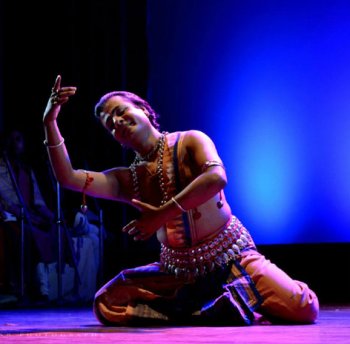
|   |

|   |
Hey Mor Devota - Nita Vidyarthi e-mail: nitavidyarthi@gmail.com October 12, 2013 Students, teachers and associate members of Srijan Chhanda offered tribute to Rabindranath Tagore on the centenary year of his Gitanajali and Guru Kelucharan Mohapatra on his 10th death anniversary, with their latest production ‘Hey Mor Devota’ at the Uttam Mancha, Kolkata. Hey Mor Devota was a “blend of thoughts of the Vedas, the Upanishads and Gitanjali presented through classical dance along with music and poetry.”  Rajib Bhattacharya, who spearheads the institution, is a dedicated Odissi dancer and a very sincere teacher. In keeping with the latest trend of having an elaborate felicitation program, the evening began by honouring and felicitating stalwarts in the field of performing arts like Girija Devi, her daughter Sudha Dutta, a devoted disciple of Guru Kelucharan Mohapatra, Ustad Raza Ali Khan, acclaimed dancers Dr. Mahua Mukherjee and Sharmila Biswas, theatre persons Seema Mukherjee and Sohini Sengupta. The performance was a combination of dance, recitation, songs and chants from the Rigveda. With the blessings of Girija Devi and the seniors, the chanting of “Hari Om Narayana” by Sayon Mukhopadyay and “Shrinantu vishwey amritasya putra” in chorus by the members of the organisation, the evening began with the reading of “Srishtir sudur atitey bishwa prakritir sobuj gacher patar prothom surjey komol sparsha” by veteran Pranati Thakur tracing the early years of Creation with the touch of delicate rays of the sun. The chorus “Jagatey Ananda Jogney” was accompanied by a group Odissi presentation by three male and two female dancers interspersed with the reading in obeisance to the five elements. This was followed by a fine solo by Rajib acknowledging love (For God) in “Ei je tomar prem ogo” sung beautifully by Manoj Murali Nair, the young exponent of Rabindrasangeet. From the Vedas, an ode to joy or ananda, a concept almost central to Rabindranath was explored in “Ananda anandati anandam prayantey” by Sayan, a joyful execution of “Aanaderi sagar hotey eschhey aaj baan” (a flood from the sea of happiness) recited by Pranati Thakur, a lovely “Kobey ami bahir holem” by Manoj and a neat duet by the male dancers. At this point the play of light and darkness was figuratively presented accentuated with a fine number “Megher porey megh jomachhay,” that popular number “Cloud heap upon clouds and it darkens” from Gitanjali by the acclaimed singer Indrani Sen but its context with the theme was confusing. The performance text started losing its grip from this point onwards, even though there were some beautiful individual songs by both Manoj (Jiban jokhon shukaye jaye) in a fine choreographic item and Indrani Sen. Rajib was also quite convincing in the number “Aamar matha noto korey dayo” and “taye tomar ananda amar por” but once again there was lack of coherence with the theme. It was good to hear Manoj in a soulful “Daya diye hobey go more jibon dhutey.” The best group dance was “Ei aasantoley” which followed the title song “Hey mor Devota.” Some of the group dances lacked neatness primary due to lack of harmony, the male dancers being more confident than the female dancers. The chorus too was amateurish. The performance space was not adequate and there was crowding as the rear part of the stage was occupied partly by the elocutionists Pranati Thakur, Subhashis Chakravarty and Sayon Mukhopadyay and the left wings by the singers and accompanists. Uttam Mondal is a competent mardala player but the sound system and dampening effect played havoc with the instrument and subsequently with the music. And as usual Dinesh Poddar’s excessive use of blue lights and smoke to create a mystifying effect (not in accordance with the theme) drowned the dancers causing blurred partially visible imagery, instead of the visual delight of the dance movements. Sayon Mukhopadyay, a young practitioner of Dhrubapada and the Vedas, did not have ample scope to apply his insight in tracing the affinity of Tagore with ancient texts of the Vedas in creating some of his poetry in Gitanjali that took the world by storm a hundred years ago. The effort conceived, choreographed and directed by Rajib Bhattacharya is appreciable but the script by Suvadeep Chakravarty and accordingly some songs have to be reworked and tightened a bit to avoid digression from the title theme. Dr. Nita Vidyarthi is a critic of performing arts, specialising in dance, dance theatre and expressions and is a regular contributor to The Hindu, and the Statesman Kolkata in dance, vocal music and theatre. She is trained in Kathak, Bharatanatyam and Manipuri as well as vocal, semi-classical music and Rabindra Sangeet. A Science communicator, Ph.D. in Polymer Science, Commonwealth Scholar and a retired Professor of Chemistry, Nita devotes most of her time to dance and theatre writing. |